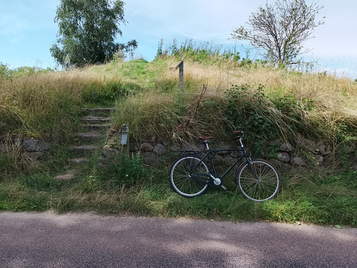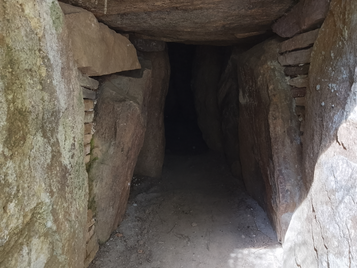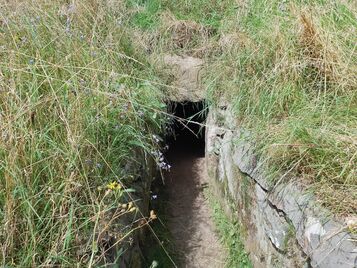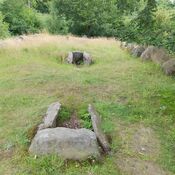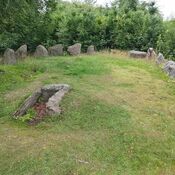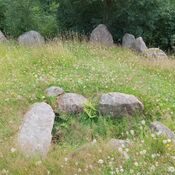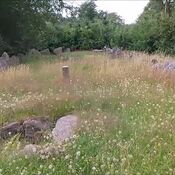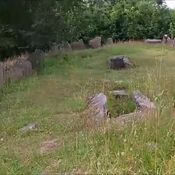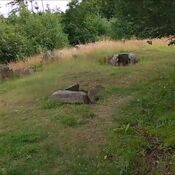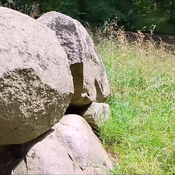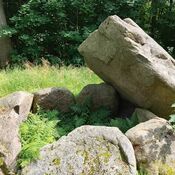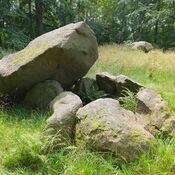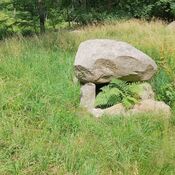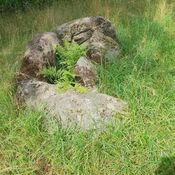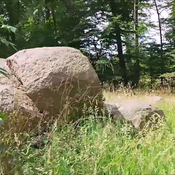The Skjerningehøj (also referred to as Skerningehøj) is an exceptionally well-preserved passage grave (Jættestue/Ganggrab) located in Svanninge on South Funen, Denmark. The structure is dated to the Neolithic Stone Age, specifically between approximately 3950 and 2800 B.C.. It is considered one of the best-preserved passage graves on Funen and serves as an instructive and beautiful example of the structure and interior appearance of such a monument. It is assumed to have been built by people of the Funnelbeaker Culture (Trichterbecherkultur) and likely functioned as a collective burial site and a place for religious rituals over generations.
Skjerningehøj consists of a round, beautiful, and well-preserved burial mound (Rundhøj) which is grass-covered. The dimensions of the mound vary slightly in historical records, being noted as approximately 2.5–2.8 meters high by 28–29 meters in diameter, or 3.5 meters high by 32.0 x 27.0 meters, with an overall height of 2.5 to 3.5 meters and a diameter of 27 to 32 meters.
Within the mound lies an oval stone chamber oriented ENE-WSW (ØNØ-VSV). The chamber measures about 3 x 2 meters and is constructed of nine large supporting stones (sidesten) and two large capstones (overliggere). The gaps between the supporting stones are sealed with stone slabs (tørmur), which are described as being extraordinarily well-preserved. Parts of the capstones are visible on the surface of the mound.
The chamber is accessed from the south via a passage (gang), oriented SSE-NNW (SSØ-NNV). This passage consists of at least four pairs of original supporting stones and is covered by two, presumably original, capstones. Outside the covered section is an open, paved gang, 3–4 meters long, leading down via a stone staircase. Historically, the chamber was closed with an iron door.
The monument has a long history of investigation and restoration:
A private excavation took place in 1812 by which Stone Age tools and "urns with ashes and bone fragments" were found.
The National Museum performed official surveys in 1874, 1885, 1947, and 1987.
Restorations were conducted by the National Museum in 1910 and 1943.
In 2018, officials found that a supporting stone in the passage had tilted forward, causing earth fill to slide into the passage.
Due to safety concerns, access to the chamber was blocked in 2019.
A major restoration was performed in 2023. During this process, the tilted stone was re-erected after a capstone was lifted. It was discovered that traces on an unusually long keystones suggested an attempt to gain access to the passage/chamber at that specific spot had occurred during the 1812 excavation.
Skjerningehøj is a protected site. While part of the mound's base is cut off to the east by a public road, the site appears well-maintained and currently offers good access from the road.
The passage is somewhat narrow, but the site is now generally accessible again. Visitors are recommended to bring a lamp and wear sturdy clothing to access the unusually beautiful chamber.
In the past, poor condition of the gate and information sign was noted. Furthermore, there has been a recurring desire from both officials and the property owner for improved signage at the site, as it has previously been absent.
https://www.kulturarv.dk/fundogfortidsminder/Lokalitet/8501/

